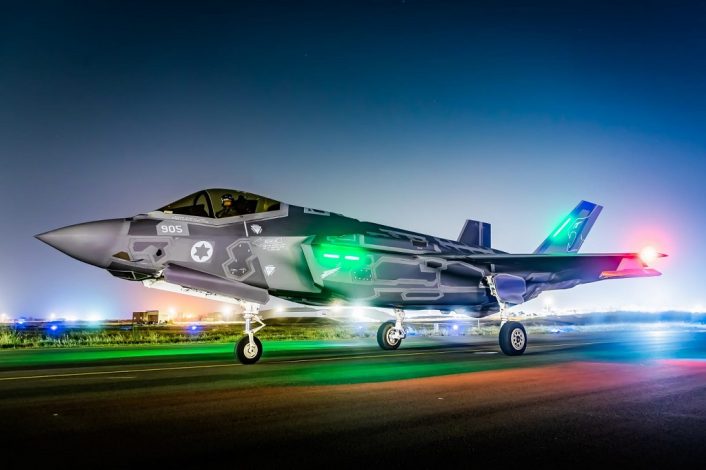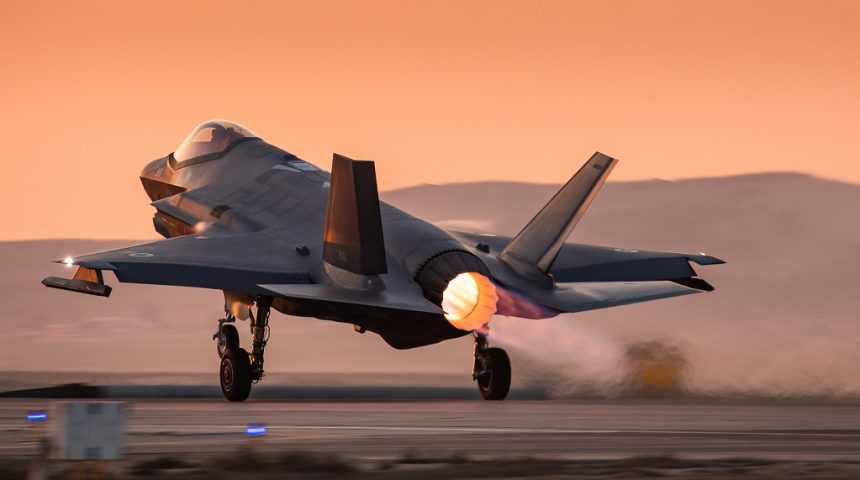A local newspaper reported that the development of external fuel tanks for the F-35 is still ongoing and will possibly be complete in two years.
It is no secret that the Israeli Air Force considers the combat range as one of the most important factors when adopting a new fighter aircraft and that, because of this, it was the first operator to ask for external fuel tanks for the F-35 Lightning II or, more specifically, for the customized F-35I Adir. The first studies for new fuel tanks started at least during the system design and development phase (SDD) of the 5th gen aircraft, but after 2019 nothing new surfaced, at least online. Until, a few days ago, the Israeli news website Walla reported that development is still ongoing.
According to Walla, the Israeli Air Force Flight Testing Center (FTC) at Tel-Nof AFB is developing the external drop tanks that will help the Adir to complete long-range missions over “third circle” targets, such a hypothetical strike against Iranian objectives, without the need for aerial refueling, while also allowing an extended time on station (TOS) over the targets. The report mentions also significant progress in the integration of Israel-made missiles on the F-35I.
Before moving on, here is a brief explanation of the “third circle” from the Times of Israel: “The “third circle” refers to the three levels of direct threats facing Israel, the first being small terror groups on Israel’s borders, like Hamas; the second being larger threats, like the Syrian army and Hezbollah; and the third being countries that do not share a border with Israel, like Iran and Iraq.”
The development of the new fuel tank is the result of the collaboration of Israel’s Ministry of Defense, Air Force and defense industries that aims to upgrade the strategic capabilities of the Israel Defense Forces (IDF) against “third circle” countries. This process is quite delicate, as the new external fuel tanks need to not degrade too much the low observability of the F-35 and this can be done mainly through the shape and materials chosen.
Also, a detachable tank should include some measures to mitigate the effects that its pylon’s attachment points would have on the low observability, after the tanks are jettisoned once emptied before reaching the target. In fact, even though the tanks and their pylons are dropped, the attachment points and fuel lines would not be covered by any Radar Absorbing Material (RAM) and possibly expose the Adir to unwanted radar reflections.
IDF sources mentioned by Walla in their report said that the development and production process of the new external fuel tanks for the F-35I Adir will not exceed two years. The first reports about the ongoing planning and initial development process were published by Aviation Week in 2019, when Israel Aerospace Industries (IAI) and Cyclone, a subsidiary of Elbit Systems, completed the initial design studies on both a conformal fuel tank (CFT) design and a 600-gallon drop tank, respectively.
The F-35A, from whom the F-35I was developed, has an internal fuel tank capacity of slightly less than 18,500 lb (8,391 kg, the exact amount varies depending on the source) and a non-classified range and combat radius in excess of 1,187 nm (2,200 km) and 594 nm (1,100 km), respectively. The fuel is contained in several tanks inside the wings and fuselage to preserve the stealth profile. With the two 600-gallon drop tanks under its wings, the F-35I would increase its total fuel capacity by approximately 40%, as each tank would add about 4,000 lb of fuel for a total of more than 26,500 lb.
It is not known how the new external fuel tanks will be shaped. During the SDD phase, the F-35 was expected to use the U.S. Navy’s standard 480-gallon tanks already operational on the F/A-18. However, wind tunnel testing showed that the standard tanks would create dangerous store release conditions, with the released weapons possibly striking the aircraft. With the heavy use of Computational Fluid Dynamics (CFD) modeling, different designs were tested and a safer aero-shaped 426-gallon tank was ultimately approved for the F-35, but it didn’t make it into the production stage

According to some sources, the Israeli Air Force inquired if it was possible to adapt the 600-gallon external fuel tanks of the F-22 Raptor to be used also by the F-35. And here comes again the shape problem: the F-22 uses the drop tanks only for ferry flights or flight without external air-to-ground ordnance (which is carried only internally); if the F-35 Adir was to use the drop tanks only, without external weapons, the Raptor’s drop tanks might be feasible, but if the Israelis want to use also the fuel tanks with the Adir for combat missions or in “Beast mode” and heavy external weapons, a tank redesign might be needed, as happened during the SDD.
If the 600-gallon fuel tanks become operational with the Adir, the IDF would have the capability to use the F-35 in long-range strikes against Iran in a similar fashion as the famous Operation Opera, with heavy loaded aircraft departing Israel fully packed with fuel and dropping the external tanks once empty, arriving on target with a clean aircraft and minimal degradation of the low observability. Also, this would allow the IDF to safely use their limited number of tankers, without having to put them at risk near hostile airspace.
According to The Warzone, Lockheed Martin is also now considering working to certify a 600-gallon drop tank design for all F-35As, possibly to be used also in conjunction with the “Beast mode”. Even for a country like the United States that does not lack tankers, the addition of new drop tanks to the F-35’s stores would be a much-welcomed option to reduce the reliance on the tankers during long-range missions in new theaters like the Pacific Ocean.
In a hypothetical conflict in the South China Sea, the F-35s might not be able to get inland far enough to hit their targets while leaving the tankers at a safe distance after the last of multiple refuels on their way in, with obvious downsides other than the reduced range and the higher “bingo fuel” required to safely reach again a friendly airport to land.
This problematic reliance on the tankers was notable in a recent exercise earlier this month, when four F-16CM Block 50 of the 35th Fighter Wing based at Misawa Air Base, Japan, flew all the way to the South China Sea to perform an overflight of the USS Theodore Roosevelt (CVN-71) aircraft carrier. For this mission, four KC-135 Stratotankers were required, with an unspecified number of air-to-air refuelings along the way.









